Regions
Latemar, Southern Adamello, Primiero - Pale di S. Martino, Adamello - Presanella, Northern Brenta - Peller, Western Nonsberg Alps, Southern Brenta, Fassa Valley, Sole, Pejo and Rabbi, Southern Lagorai, Northern Lagorai, Maddalene, Paganella, Pine' - Mocheni Valley
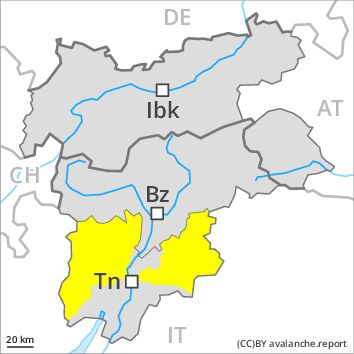
Danger level
Danger Level 2 - Moderate above the treeline
Danger Level 2 - Moderate above the treeline
Avalanche Problem
Persistent weak layer above 2400m, N-NE-NW
New snow above 1400m, N-NE-E-SE-S-SW-W-NW

In particular in the southwest and in the southeast some fresh snow above approximately 1200 m.
Over a wide area 15 cm of snow, and even more in some localities, will fall until the evening above approximately 1200 m. It must be evaluated with care and prudence in particular on steep shady slopes. Weak layers exist in the snowpack in particular on steep northeast, north and northwest facing slopes. They can be released in isolated cases, but mostly only by large additional loads, in high Alpine regions. This applies especially above approximately 2400 m and adjacent to ridgelines. These avalanche prone locations are difficult to recognise. As a consequence of the rain, the likelihood of moist and wet avalanches being released will increase a little in particular on steep slopes at low altitude.
Snowpack
In some places fresh snow and wind slabs are lying on a moist old snowpack. The older wind slabs have bonded well with the old snowpack. In very isolated cases weak layers exist in the old snowpack on shady slopes, in particular on shady slopes above approximately 2400 m. At low altitude a little snow is lying.
Tendency
Slight decrease in avalanche danger as the snowfall level drops.
Regions
Val Müstair Alps, Western Verwall Mountains, Langtaufers, Eastern Verwall Mountains, Schnals Ridge, Silvretta, Southern Stubai Alps, Samnaun Mountains, Southern Zillertal Alps and High Tauern, Northern Oetz and Stubai Alps, Western Tuxer Alps, Texel Mountains, Eastern Tuxer Alps, Western Pfunderer Mountains, Glockturm Range, Eastern Pfunderer Mountains, Durreck Range, Weißkugel Range, Western Rieserferner Mountains, Gurgler Range, Central Stubai Alps, Ortler Range, Northern Zillertal Alps, Allgäu Alps, Venediger Range, Eastern Lechtal Alps - Ammergau Alps, Eastern Rieserferner Mountains, Glockner Range, Western Lechtal Alps, Central Lechtal Alps, Grieskogel Mountains
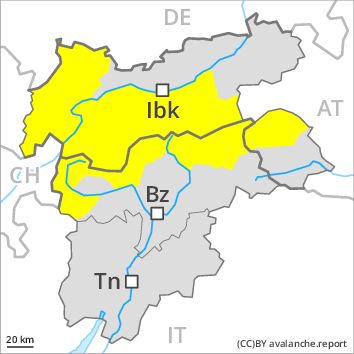
Danger level
Danger Level 2 - Moderate above the treeline
Danger Level 2 - Moderate above the treeline
Avalanche Problem
Wind-drifted snow above the treeline, N-NE-E-W-NW

Wind slabs are in some cases prone to triggering above the tree line.
As a consequence of fresh snow and a sometimes strong westerly wind, mostly small wind slabs will form in particular above the tree line. These are in some cases prone to triggering, especially adjacent to ridgelines and in gullies and bowls. These avalanche prone locations are rather rare and are clearly recognisable to the trained eye. Mostly the avalanches are rather small but in some cases easily released.
In addition the no longer entirely fresh wind slabs should be taken into account, in particular on extremely steep shady slopes above approximately 2800 m.
Snowpack
dp 6: cold, loose snow and wind
At low altitude no snow is lying. At intermediate altitudes the snow is wet. Outgoing longwave radiation during the night will be barely evident. The fresh and somewhat older wind slabs have bonded well with the old snowpack in all aspects below approximately 2000 m. In some places fresh snow and wind slabs are lying on soft layers. This applies in particular above approximately 2000 m on shady slopes. In very isolated cases weak layers exist in the old snowpack in particular on west, north and northeast facing slopes, especially above approximately 2600 m.
Tendency
Hardly any increase in avalanche danger as a consequence of the snowfall.
Regions
Eastern Deferegger Alps, Schober Mountains, Lienzer Dolomites
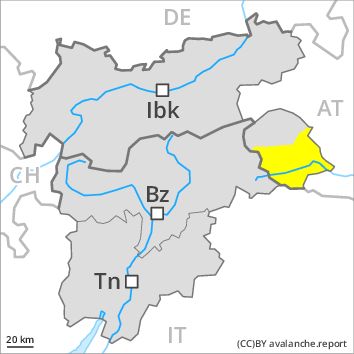
Danger level
Danger Level 2 - Moderate above the treeline
Danger Level 2 - Moderate above the treeline
Avalanche Problem
Wind-drifted snow above the treeline, N-NE-E-W-NW

Wind slabs are in isolated cases prone to triggering above the tree line.
As a consequence of fresh snow and a sometimes strong westerly wind, rather small wind slabs will form in particular above the tree line. These are in isolated cases prone to triggering, especially on very steep shady slopes above the tree line adjacent to ridgelines. These avalanche prone locations are very rare and are clearly recognisable to the trained eye. The avalanches are rather small but in some cases easily released.
Snowpack
dp 6: cold, loose snow and wind
At low altitude no snow is lying. At intermediate altitudes the snow is wet. The somewhat older wind slabs have bonded well with the old snowpack in all aspects. Fresh wind slabs require caution.
Tendency
Hardly any increase in avalanche danger.
Regions
Karwendel Mountains, Brandenberg Alps, Western Kitzbühel Alps, Wilder Kaiser Mountains - Waidring Alps, Eastern Kitzbühel Alps, Mieming Mountains
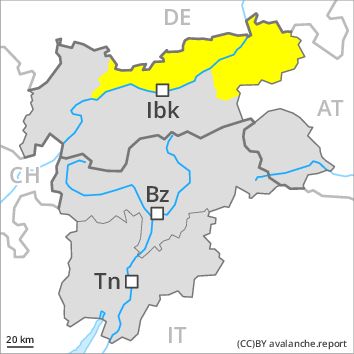
Danger level
Danger Level 2 - Moderate above the treeline
Danger Level 2 - Moderate above the treeline
Avalanche Problem
Wind-drifted snow above the treeline, N-NE-E-W-NW

Wind slabs are in some cases prone to triggering above the tree line.
As a consequence of fresh snow and a sometimes strong westerly wind, mostly small wind slabs will form in particular above the tree line. These are in isolated cases prone to triggering. Caution is to be exercised in particular adjacent to ridgelines and in gullies and bowls. These avalanche prone locations are rather rare and are clearly recognisable to the trained eye. Mostly the avalanches are rather small.
Snowpack
dp 6: cold, loose snow and wind
At low altitude no snow is lying. At intermediate altitudes the snow is wet. Outgoing longwave radiation during the night will be barely evident. The somewhat older wind slabs have bonded well with the old snowpack in all aspects. Fresh wind slabs require caution.
Tendency
Hardly any increase in avalanche danger as a consequence of the fresh snow.
Regions
Prealps, Cembra Valley, Bondone and Stivo, Vallarsa, Folgaria - Laverone, Ledro Valley, Marzola - Valsugana

Danger level
Danger Level 2 - Moderate above the treeline
Danger Level 2 - Moderate above the treeline
Avalanche Problem
Wet snow above 2000m, N-NE-E-SE-S-SW-W-NW
New snow above the treeline, N-NE-E-SE-S-SW-W-NW

Moist and wet avalanches require caution. As a consequence of rain an unfavourable avalanche situation will still be encountered.
Mostly small natural avalanches are possible in particular in steep rocky terrain. As a consequence of the rain, the likelihood of moist and wet avalanches being released will increase for a while in particular on rocky slopes at low and intermediate altitudes. Significant decrease in danger of moist and wet avalanches as the snowfall level drops.
Snowpack
Fresh snow and wind slabs are lying on a wet old snowpack. In some places fresh snow is lying on old snow containing large grains. This applies in particular on shady slopes at high altitudes and in high Alpine regions. At low altitude no snow is lying on south facing slopes.
Tendency
Slight decrease in avalanche danger as the snowfall level drops.
Regions
Gröden Dolomites, Prags Dolomites, Sarntal Alps, Sexten Dolomites, Western Deferegger Alps, Ulten Valley, Eastern Nonsberger Alps, Northern Dolomites of Fiemme, Saldurn-Mastaun Ridge
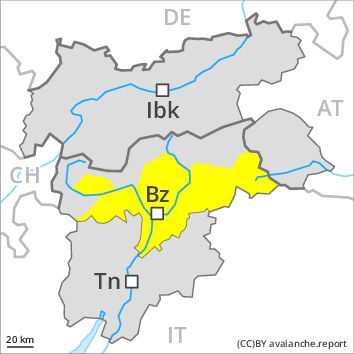
Danger level
Danger Level 2 - Moderate
Avalanche Problem
Gliding snow above 2600m, E-SE-S-SW-W
Wind-drifted snow above 2400m, N-NE-E-NW

Gliding snow represents the main danger. Wind slabs are in isolated cases prone to triggering at high altitudes and in high Alpine regions.
Gradual decrease in danger of wet avalanches as the temperature drops. Not yet all gliding avalanches have been released especially on steep grassy slopes. Caution is to be exercised in areas with glide cracks.
As a consequence of a sometimes strong westerly wind, small wind slabs will form as well. These are in isolated cases prone to triggering, especially on very steep shady slopes above approximately 2400 m adjacent to ridgelines. These avalanche prone locations are very rare and are clearly recognisable to the trained eye. The avalanches are only small.
Snowpack
dp 2: gliding snow
dp 6: cold, loose snow and wind
At low altitude no snow is lying. At intermediate altitudes the snow is wet. Outgoing longwave radiation during the night will be reduced. The somewhat older wind slabs have bonded well with the old snowpack in all aspects. Fresh wind slabs require caution.
Tendency
Further decrease in danger of moist avalanches as the temperature drops.






